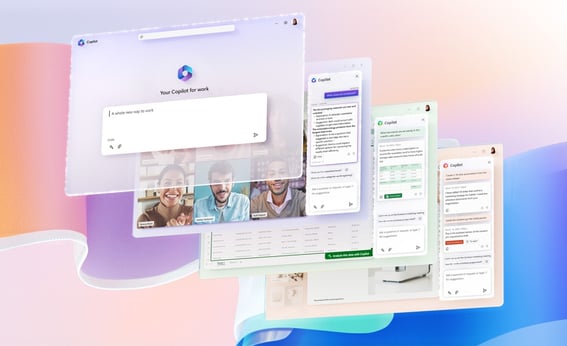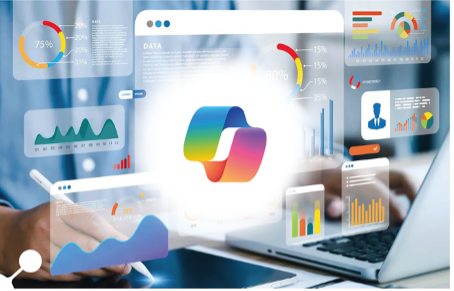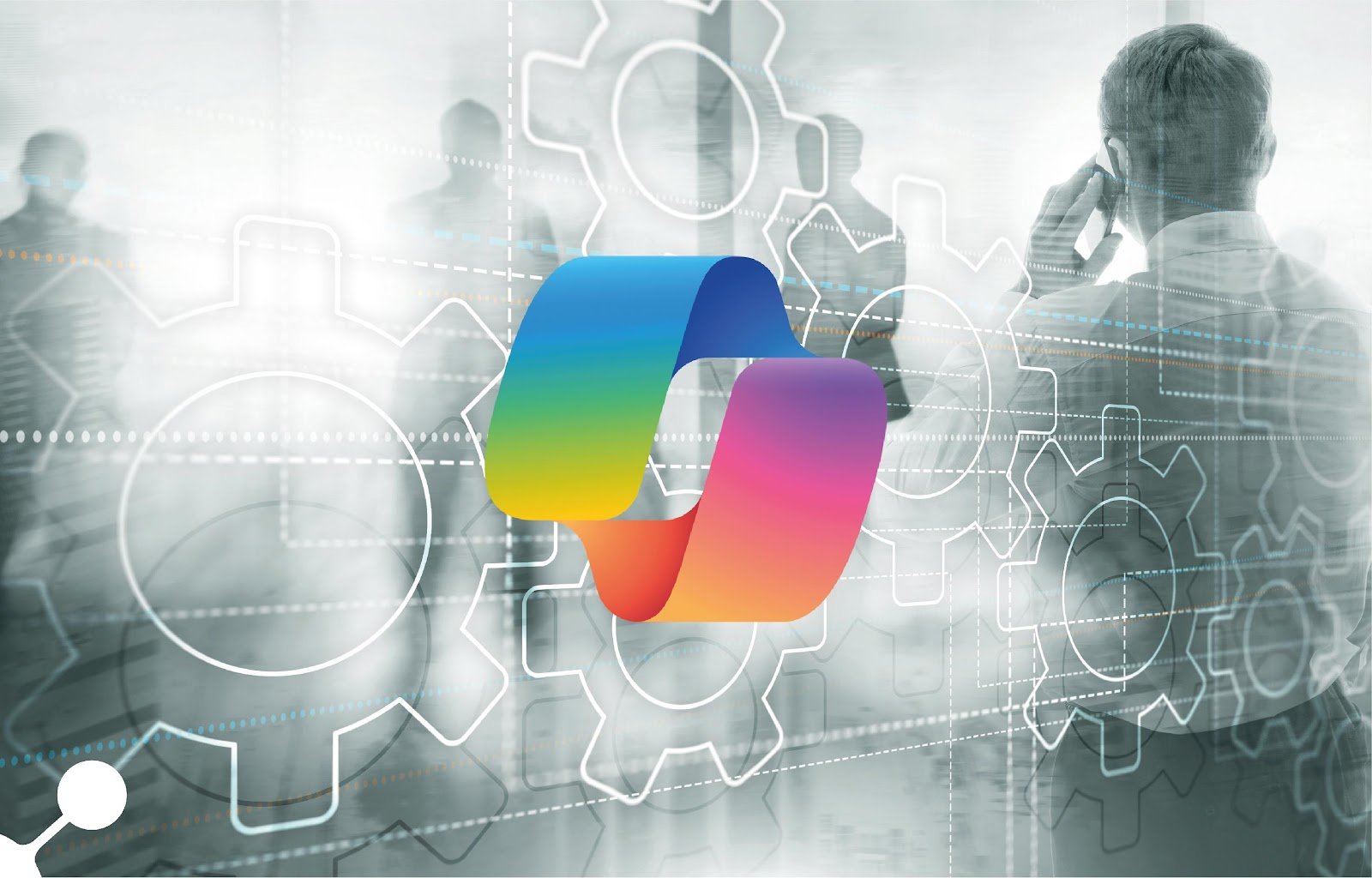How Microsoft’s generative AI Copilot offers unparalleled productivity

Generative AI has the potential to revolutionize business processes and dramatically enhance productivity. Microsoft is at the forefront of this innovation, having partnered with OpenAI to integrate its renowned ChatGPT language model into a powerful new enterprise solution for Microsoft 365: Copilot.
As we’ll explore in this blog, there are some huge advantages to using Copilot. Despite this, it’s also understandable that many organizations are still a little cautious; AI is a relatively new technology, after all. On the other hand, it can be an advantage to start gaining superior productivity sooner, or run the risk that your competitors will beat you to it.
Knowledge is power. So, let’s get to know Copilot better and learn what it can do for your organization.
What is Microsoft Copilot?
Microsoft Copilot is an intelligent assistant that combines the strengths of pre-trained large language models (LLMs) with the knowledge and contexts from your own organization’s enterprise content, which it accesses using Microsoft Graph APIs and connectors.
As an intelligent assistant, it provides accurate and appropriate real-time responses that reflect the context and knowledge derived from your digital content. While public LLMs like ChatGPT use publicly sourced content to inform responses, Copilot works only with the specific enterprise content you define, in line with your data policies. This keeps your information secure within the compliant Microsoft framework.
Microsoft Copilot can boost productivity by combing through vast quantities of data to identify inconsistencies or opportunities, and it can help to increase data-driven decision-making. It’s highly customizable and works with almost all the products in the MS365 family. These include key applications like Edge, Office Suite, Outlook, Power Automate, Teams, SharePoint, and many others.
By using natural language to control Copilot, everyone in your organization can benefit from an intelligent assistant. The barrier to increased productivity is substantially lowered, and work can become more rewarding.
We’ll look more closely at the potential downsides in a moment, but first, let’s look at some simple everyday ways that Copilot can make your life easier.
Examples of what Copilot can do (in just a few seconds!)
These are just a few illustrations of the kinds of different tasks Copilot can support. When giving a prompt, you need to define a specific resource or content you want it to use; in these examples, this is indicated with bold text.
In practical situations, you’ll need to create more specific prompts than the given examples, using the specific parameters and resources used for your organization.
Example 1: “Create a bullet list of the main points from this meeting transcript”
In this case, you identify a specific file for the transcript. Copilot skims through it and instantly creates a simple summary of the main points of discussion. A simple, yet typically time-consuming job, completed in seconds. OK, what else?
Example 2: “Build an automation that follows up with a client after 2 weeks from the previous contact on the CRM timeline, and draft an email text for this”
With Copilot integrated with Power Automate, you can instruct it to build draft automation in moments, using your own CRM as a resource. A draft email can also be created, looking at your usual pattern of interaction as a template. This can be fine-tuned and adapted with editing and more specific prompts.
Example 3: “Create a presentation about our activities in the APAC region between 2020-2023 using the resources and information in this folder”
By defining a content resource for information about your activities in the APAC region, you can create a highly specific draft presentation to which you can then add your own creative flair, expertise, and insight.
Example 4: “Reschedule this meeting for the same time next week, and write a draft email to all attendees to inform them and apologize”
Running late? Let Copilot take care of it. Working seamlessly with Teams, your calendar, and Outlook, Copilot can make sure no one is left waiting. A draft email can be written, checked, adjusted, and sent to all recipients in just a moment.
Example 5: “Write a draft proposal, based on the client’s needs and the prices we discussed in this email thread”
Using template proposals as inspiration, Copilot summarizes the key facts and agreed-upon details from a specified email thread into a professional, formal draft proposal. After reviewing it, you can instruct Copilot to send it via Outlook.
Example 6: “Identify the best performing provider from the data in this spreadsheet”
Big data can be a massive headache, but not for algorithms. Copilot can comb through massive and complex spreadsheets to determine correlations or unusual data patterns. Identifying how partners or suppliers perform relative to each other is no longer a subjective matter – Copilot can look at the data, so you know for sure. Problem suppliers that hurt your reputation are easier to find and weed out.
What is the cost of using Copilot?
Private individuals can try out a free version of Copilot to see what it’s capable of, but it’s only really a demonstration of the basic capabilities and barely scratches the surface. Most enterprise customers will select a Copilot for a Microsoft 365 subscription at an additional monthly cost. While you get a lot of value from Copilot, the only other additional costs will come from the potential for increased (cloud) server workloads.
Thankfully, the MS365 platform accommodates additional workloads very easily, thanks to elastic scalability and a pay-as-you-go model. Cost control is important; however, so continuous cost monitoring is a wise way to maintain a tight grip on costs.
How easy is it to use Copilot?
As it relies on using natural language, Copilot is very easy to use.
However, while the expectations of seamless collaboration may be very high, the reality is that it takes some work to get the most value from Copilot.
It is possible to achieve incredible gains in productivity and efficiency, achieving a kind of perfect symbiosis, in time. But the key is investing sufficient time in user training and customization, for each application you use it with.
How secure is Microsoft Copilot?
People familiar with the security concerns surrounding public LLMs like ChatGPT are often apprehensive about the security of Copilot. After all, it is basically a Microsoft version of ChatGPT, right?
Organizations can rest assured: while Copilot is based on the LLM framework of OpenAI’s well-known ChatGPT, Copilot is a different class of tooling altogether, one built for the tough challenges of enterprise users.
The biggest worry is that sensitive data is leaked or handled in a non-compliant way. So, let’s address this concern first.
Copilot leverages Microsoft’s robust permissioning model to prevent data from inadvertently leaking across user groups or into the public domain. End-to-end encryption and automated compliance checks are built in. Additionally, its large language models are not trained on your prompts or tenant data. Instead, Copilot operates as a private pre-trained model, using your organization’s enterprise content to generate responses that remain within Microsoft’s compliant framework.
In other words, according to Microsoft:
“Copilot presents only data you can access using the same technology that we’ve been using for years to secure customer data.”
So, there’s no big worry about the security Copilot itself, as it meets all the rigorous standards of MS365.
Of course, organizations must still follow all the best practices for security and governance within Microsoft 365, by setting up measures like Identity and Access Management (IAM), role-based access control (RBAC), and other security best practices. Provided it’s all configured properly, you can expect no issues in this regard.
How easy is it to integrate Copilot with your existing infrastructure?
As already touched upon, Copilot uses Microsoft Graph to connect with (and provide AI support for) numerous applications in the MS365 family. This means that if your infrastructure is entirely Microsoft-based, then you can expect seamless integration with your current systems.
If, on the other hand, you use a variety of systems alongside MS 365, then you need to take some preparatory steps to get the most out of Copilot. Preparation goes a long way to ensuring a smooth integration process, and this can be a good opportunity to take stock of your enterprise content and bring it all into MS 365. With everything in an MS365-based ECM, you gain agile content that delivers greater value.
How can you make the most of Copilot?
There are always high expectations from new technologies, and this can lead to a ‘trough of disillusionment’. This phrase, coined by Gartner, describes what happens when organizations are aware of the potential value, but just aren’t getting it. This is because other factors are needed for success (like training or supporting technologies), and these haven’t yet reached the same level of maturity.
In this case, to make the most from Copilot, it’s essential that it can access your enterprise content and that your content is of sufficient quality.
You want the algorithm to reflect your business at its best, but it can only go on the content you provide. This means doing more than just getting rid of clutter, like old templates and outdated files. It also requires an intelligent system for organizing and structuring content, with folders and metadata. Moving forward, a strategy for content care will become the key to getting the most value from the way your organization leverages its enterprise content, including with Copilot.
Get set for takeoff
There are 4 crucial steps you must take to get the most value from your content: Unlock, Migrate, Activate, and Care. These will get you on the right track for maximizing the productivity of Copilot (and the rest of MS365).
Intrigued by the possibilities? Get the full details. Read our whitepaper and get a comprehensive flight plan for success with Microsoft 365 Copilot.
Share this
You May Also Like
These Related Stories

Integrate task-specific content with Microsoft 365 Copilot

How Agile Content is the key to unlocking your productivity potential

No Comments Yet
Let us know what you think